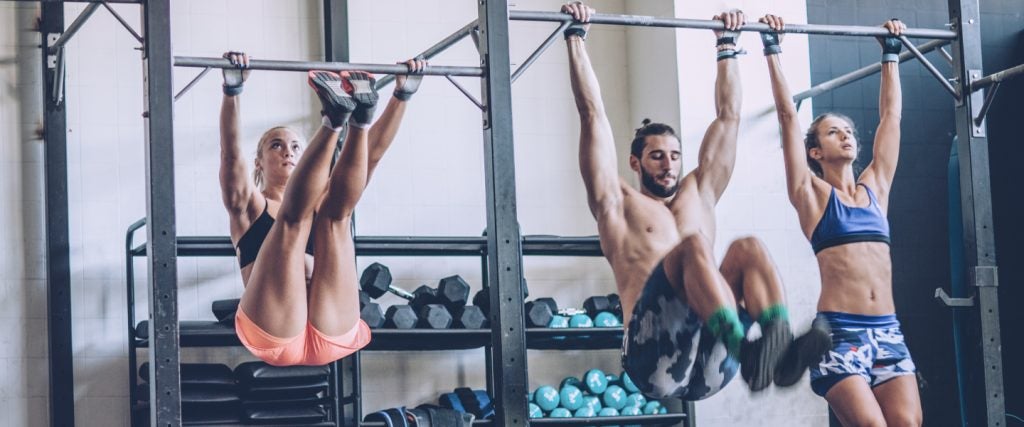From the time of their creation, the intention of pull-ups and chin-ups was to develop the pulling strength of the individuals who employed them, just as the push-up and dip were intended to measure and enhance pushing strength. When utilized in concert, they should be able to provide respectable strength and muscle development in all parts of your upper body without having to resort to any other forms of exercise.
That’s precisely what the military branches are intending to measure by requesting recruits and active service members to display their proficiency in the push-up and pull-up. It’s also a way of identifying those who have an ideal level of mastery over their own bodyweight, or their strength-to-bodyweight ratio.
Then CrossFit came along and seemingly changed the very definition of what a pull-up is, with its total-body inclusion, utter disregard for muscle control during the descent from the bar and apparent disinterest in shoulder joint integrity or health. Of course, it doesn’t help pull-up purity arguments when Guinness permits pull-up world record submissions in which the demonstrated form comes perilously close to resembling the flopping motion exhibited during CrossFit pull-up competitions.
So that begs the question as to whether or not the two pull-up variations are even striving to accomplish the same thing.
What was the pull-up intended to do in its original form?
The traditional pull-up primarily uses the power of the lats — with assistance from the biceps, posterior deltoids, trapezius and abdominals — to move the body upwards and downwards in a controlled movement. Again, it’s intended to train and gauge the power of your posterior chain. Moreover, in order to do pull-ups most effectively, the optimal form requires the maintenance of muscle tension throughout the body in order to minimize swaying and to ensure that the eccentric phase of the lift — i.e., when the body is being lowered — is as controlled as the concentric phase.
How is the CrossFit pull-up different?
The CrossFit pull-up, also known as the kipping pull-up, is the polar opposite in several respects. The movement begins with a loose, swinging body as opposed to one that’s tense and rigid. It involves the use of the hips to drive the body’s momentum up toward the bar, thereby minimizing the amount of posterior chain strength required to get the chin to the bar. It also necessitates minimal muscle control during what would ordinarily be the eccentric phase of the movement.
In essence, the kipping pull-up is what you’d end up with if the only purpose of a pull-up was to 1) hang from a bar by both of your hands; 2) maneuver your chin within two inches of the bar using only your own physical efforts; and 3) return your body to its starting depth.
Obviously, this makes kipping pull-ups far easier to complete in high numbers than regular pull-ups. The kipping pull-up is also a spiritual sibling to the powerlifting style of the bench press that’s performed with the back in an exaggeratedly arched configuration. This competition-inspired execution of a “bench press” completes the minimum requirements to qualify as an acceptable lift, but any onlookers will be left woefully unsatisfied.
In the case of kipping pull-ups, they cheat you out of any opportunity to exhibit or develop bodyweight mastery by maintaining flexed muscle control, and instead transform the pull-up into a bizarre vertical flop, akin to a hooked fish suspended from a line. It’s one of those cases where it’s true that the less dignified a training movement appears, the less productive it is.
But are kipping pull-ups real pull-ups or not?
It all depends who you’re asking, but if you’re asking me, my answer is a resounding no. I’m also pretty certain that Eugen Sandow and the strongmen of yore would agree with me.
Again, it all goes back to what the pull-up was originally intended to establish — upper-body pulling strength and endurance, along with the ability to control your own body weight by restricting yourself to the use of the muscles in your upper body.
Referring to the kipping pull-up as an upper-body exercise would be like referring to the butterfly as an upper-body swimming stroke. Yes, butterfly requires powerful back muscles in order to be performed well, but it includes a kick, body control, precise timing to coordinate the stroke with the kick and clear periods of time when the arms are out of the water and uninvolved with any of the propulsion.
Completing 20 kipping pull-ups in a row and then bragging to everyone in the gym as if you performed 20 strict, traditional, military-grade pull-ups is like telling all of your friends that you beat Contra with the Konami Code. You may bask in the admiration of the moment, but you know the truth — without all of the artificial help, your outcome would have been just as unimpressive as everyone else’s.
After all, there’s a reason why Jeff Cavaliere — my vote for the best fitness trainer in the world — refers to the CrossFit pull-up as a “fuck-up.”

